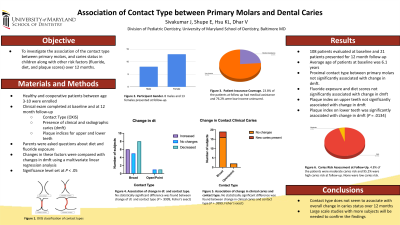Caries
93 - Association of Contact Type between Primary Molars and Dental Caries


Jhanavi Sivakumar, DMD
Resident
University of Maryland, Baltimore
University of Maryland School of Dentistry
Ijamsville, Maryland, United States- VD
Vineet Dhar, DDS
University of Maryland School of Dentistry
- KH
Kuei Ling Hsu, DDS
University of Maryland School of Dentistry
- ES
Evan Shupe, Dental Student
University of Maryland School of Dentistry

Glenn Canares, DDS MSD
Residency Program Director
University of Maryland School of Dentistry, Baltimore, MD
Baltimore, Maryland, United States
Presenting Author(s)
Co-Author(s)
Program Director(s)
Purpose: To investigate the association of the contact type between primary molars, and caries status in children along with other risk factors (fluoride, diet, and plaque scores) over 12 months.
Methods: Healthy and cooperative pediatric patients between age 3-10 years were enrolled and had a clinical exam completed at baseline and at 12-month follow-up to determine proximal contact type between primary molars, presence of clinical and radiographic caries, and plaque indices for upper and lower anterior teeth. Parents were also asked questions regarding fluoride exposure and dietary information. Changes in these factors were compared with changes in dmft using a multivariate linear regression analysis. The significance level was set at P < .05.
Results: 108 patients were included at baseline. Average patient age was 6.1 years at baseline. 21 patients presented for a 12-month follow-up. Proximal contact type between primary molars and presence of clinical and radiographic caries were not significantly associated with change in dmft. Fluoride exposure and diet scores were also not significantly associated with change in dmft. Plaque index on the upper anterior teeth was not significantly associated, but plaque index on lower anterior teeth was significantly associated with the change in dmft (P = .0134).
Conclusion: While there are many contributing factors to the development of caries, one localized factor on the tooth level (contact type) does not seem to associate with overall change in the caries status over 12 months for children. Large-scale studies with more subjects will be needed to confirm the findings.
Identify Supporting Agency and Grant Number:

.jpg)